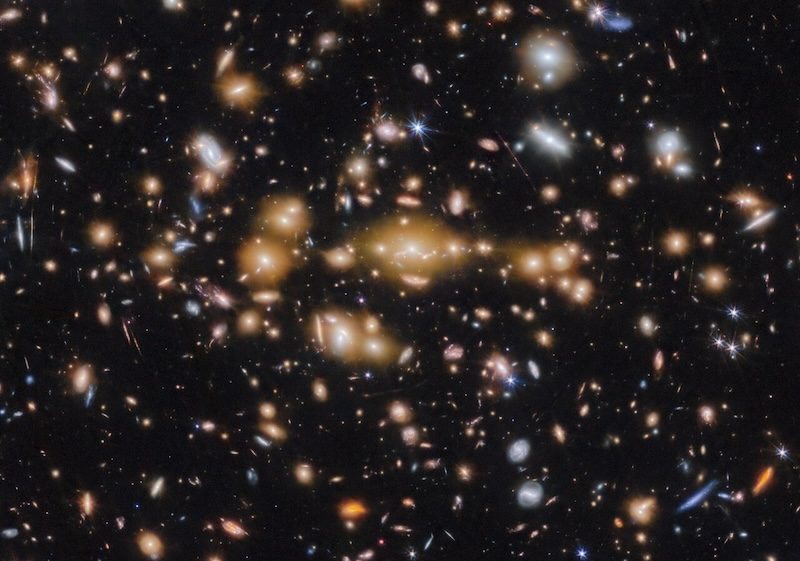Massive star clusters found in early universe
Young galaxies in the early universe went through phases of major bursts of star formation, generating substantial amounts of ionizing radiation, that is, a type of energy released by atoms that travels in the form of electromagnetic waves (gamma or X-rays) or particles (neutrons, beta or alpha). However, due to their cosmological distances, direct studies of their stellar content have proven challenging.
Using the James Webb Space TelescopeAn international team of astronomers has detected five young massive star clusters in the Cosmic Gem Arc (SPT0615-JD1). He is a galaxy strongly lensed emitting light when the universe was approximately 460 million years old, looking back at 97% of cosmic time.
The Cosmic Gems arc was initially discovered in Hubble space telescope images obtained by the (Reionization Lensing Cluster Survey) RELICS program. It was found by taking images of the lensed galaxy cluster. SPT-CL J0615-5746.
The lead author of the study is Angela Adamo from Stockholm University and the Oskar Klein Center in Sweden. Angela saying:
These galaxies are believed to be a major source of the intense radiation that reionized the early universe. What's special about the Cosmic Gems arc is that thanks to gravitational lens In fact, we can resolve the galaxy up to parsec scales!

Webb can image young, distant stars
With Webb, the science team can now see where stars formed and how they are distributed. This is similar to how the Hubble Space Telescope studies local galaxies. Webb's view provides a unique opportunity to study star formation and the inner workings of young galaxies at an unprecedented distance.
Larry Bradley of the Space Telescope Science Institute and PI of the Webb observing program saying:
Webb's incredible sensitivity and angular resolution in near infrared wavelengths, combined with gravitational lensing provided by the huge galaxy cluster in the foreground, enabled this discovery. No other telescope could have made this discovery.
According to Adamo:
The surprise and awe was incredible when we first opened Webb's images. We saw a small chain of bright spots, reflected from one side to the other; These cosmic gems are star clusters! Without Webb we wouldn't have known we were observing star clusters in such a young galaxy!
Cosmic Gems arc offers clues to early star formation
In our Milky Way we see ancient globular clusters of stars, which are bound together by gravity and have survived for billions of years. These are ancient relics of intense star formation in the early universe. However, it is not well known where and when these groups were formed.
The detection of massive clusters of young stars in the Cosmic Gem arc gives us an excellent glimpse into the early stages of a process that can continue to form globular clusters. The newly detected clusters in the arc are massive, dense and located in a very small region of their galaxy. And they also contribute most of the ultraviolet light They come from their host galaxy. The clusters are significantly denser than nearby star clusters. This discovery will help scientists better understand how infant galaxies formed their stars. Additionally, it can help astronomers see where globular clusters formed.
The team notes that this discovery connects a variety of scientific fields. Adamo explained:
These results provide direct evidence indicating that protoglobular clusters formed in faint galaxies during the era of reionization, contributing to our understanding of how these galaxies managed to reionize the universe. This discovery also imposes important limitations on the formation of globular clusters and their initial properties. For example, the high stellar densities found in clusters provide us with the first indication of the processes taking place within them, providing new insights into the possible formation of very massive stars and black hole seeds, which are important for the evolution of galaxies.
Future studies
In the future, the team hopes to build a sample of galaxies for which similar resolutions can be achieved. Eros Vanzella of the INAF Observatory of Astrophysics and Space Sciences of Bologna (OAS) saying:
I am sure that there are other systems like this waiting to be discovered in the early universe, allowing us to expand our understanding of early galaxies.
Meanwhile, the team is preparing for future observations and spectroscopy with Webb.
Bradley added:
We plan to study this galaxy with the Webb telescope. NIRSpec and MIRI instruments in Cycle 3. NIRSpec observations will allow us to confirm the redshift of the galaxy and study the ultraviolet emission from star clusters, which will allow us to study their physical properties in more detail. MIRI observations will allow us to study the properties of ionized gas. Spectroscopic observations will also allow us to spatially map the star formation rate.
Bottom line: The Webb Space Telescope has discovered massive young star clusters in the Cosmic Gem arc. This may give astronomers insight into how galaxies and globular clusters formed.
Fountain: Conjoined star clusters observed in a lensed galaxy 460 million years after the Big Bang